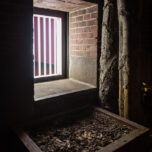Miriam Jonas and
Andreas Greiner

Opening
03/23/2018 at 7pm
Welcome
Dr. Ute Müller-Tischler
Head of Department Arts and Culture
About the exhibition
Nadia Pilchowski
and Marie-Christin Lender
Performative Intro
Ivy Lee Fiebig
Duration of the exhibition
03/23/2018 – 05/06/2018
Accompanying program
Sat 04/28/2018 3-5pm
Performances:
Ivy Lee Fiebig
Setu (Akihiro Yamamoto & Takafumi Tsukamoto)
Exhibition tour with
Nadia Pilchowski and Marie-Christin Lender
Paradigmatic for zoo architecture the structure of the Bärenzwinger (bear pit) provides a rigid separation between human and animal areas. As the first exhibition within the thematic frame of “Architectures of Segregation”, “Habitat” seeks to undermine these boundaries by means of two different artistic strategies that create new space for interpretation and experience.
Miriam Jonas, whose works often move between the poles of perfect surfaces and their immanent, covered uncanny effects, overlays the bear cages with a new layer of material. Hybrid visual references form a scenario in which an anthropomorphisation is taken literally and the formal species-neutrality of the prison architecture becomes tangible. What is the effect of an optimization of the conditions within the cages while maintaining functionality?
The examination of growth, identity and transformation of living beings are central to Andreas Greiner‘s artistic practice. Inside the Bärenzwinger, bioluminescent algae find their habitat within the architectural limitations of a sculpture. Their glow in a dark room mentally leads us back to the origins of all life. In the outdoor enclosures, a biotope for algae is forming – a project with architect Ivy Lee Fiebig, who enters into a symbiosis with the algal bloom in the creation of a biological cycle on-site. While algae already provide new solutions within the fields of industry and research, Fiebig herself is working on modular designs for living architecture.
Curated by
Nadia Pilchowski and
Marie-Christin Lender
Miriam Jonas
Miriam Jonas (*1981)
studied under Ayse Erkmen and Katharina Fritsch at the Münster Academy of Fine Arts, where she herself has taught since 2017. Prior to her studies, she received classical and technical training in scenography and sculpting at the Bonn Opera House.
Her site-specific sculptures and installations are formed mostly in direct confrontation with the circumstances of a given space and its characteristic elements.
Often they serve to comment on the existing and thus manifest in the most diverse forms, colors and materiality. We find the common thread in the material presence, while traces of the craftwork itself remain barely detectable. As an artist and craftswoman, Jonas consciously drifts into the background, bringing her works to the fore, opening up a vista to a particular, perplexing clarity.
In addition to a solo exhibition at the Greven Kunstverein, her works have been exhibited at Bar Barbette; Galerie Russi Klenner, the Dahlem Kunsthaus; Eigen+Art Lab and Kwadrat.
Andreas Greiner
Andreas Greiner (*1979) studied art and medicine at the Technical University of Dresden, the Academy of the Arts in Dresden and the UDK Berlin, among others. In 2012, he completed his MA under Olafur Eliasson at theInstitut für Raumexperimente.
Greiner operates at the interface between art and science, while confronting the reality of the consumer society.
In 2016, he was awarded the GASAG Art Prize for his exhibition “Agentur des Exponenten” at Berlinische Galerie, for which he developed a skeleton of a broiler chicken using 3D print technology, which serves as a monument to the genus.
Last year, his works were exhibited at the Arnsberg Kunstverein (Arnsberg Art Association), Hamburger Bahnhof (as part of the Festival of Future Nows), the Sprengel Museum Hannover, Galerie Dittrich und Schlechtriem in Berlin, the Krefeld Kunstverein (Krefeld Art Association) and the nbk in Berlin. Internationally, he has exhibited in Denmark, Korea and the United States.
With kind support from the interdisciplinary funding and exhibition funds of the Senate Administration for Culture and Europe as well as from “innogy Stiftung für Energie und Gesellschaft gGmbH”.
Performances
Sat 04/28/2018
3-5pm
“Koke no Ori”
by Setu
Moss with its velvety, even surface captivates with contentment and elegance. The simple beauty of Japanese moss gardens, as they are created for example in Zen Buddhist monasteries and here by the Japanese architect-artist duo Setu, consisting of Akihiro Yamamoto and Takafumi Tsukamoto, are founded in deep respect for the fine soil plant.
Striving not only for an aesthetic sense, the delicate moss that grows on the walls and between the iron bars separating the outer enclosure at Bärenzwinger, gets protected from humans, animals and dry weather and find a new optimised habitat.
“Water is heavy”
by Ivy Lee Fiebig
Within the outdoor enclosures, Ivy Lee Fiebig has been creating a biotope for algae and entered with the start of the exhibition into a symbiosis with the algae bloom, testing a biological cycle within a closed unit.
A bicycle-powered pump provides the exchange between the various organic and inorganic entities, which find themselves in continuous transformation.
In a race for the maintenance of vital conditions, the bicycle is operated to potentiate the growth of algae, thereby accelerating the process of photosynthesis and the production of energy, nutrition as well as purifying drinking water. The goal of this architectural design of an artificially produced one-woman-biosphere is to achieve equilibrium between the human, the environment and the all other living beings which inhabit it.
With kind support from the interdisciplinary funding and exhibition funds of the Senate Administration for Culture and Europe as well as from “innogy Stiftung für Energie und Gesellschaft gGmbH”.















